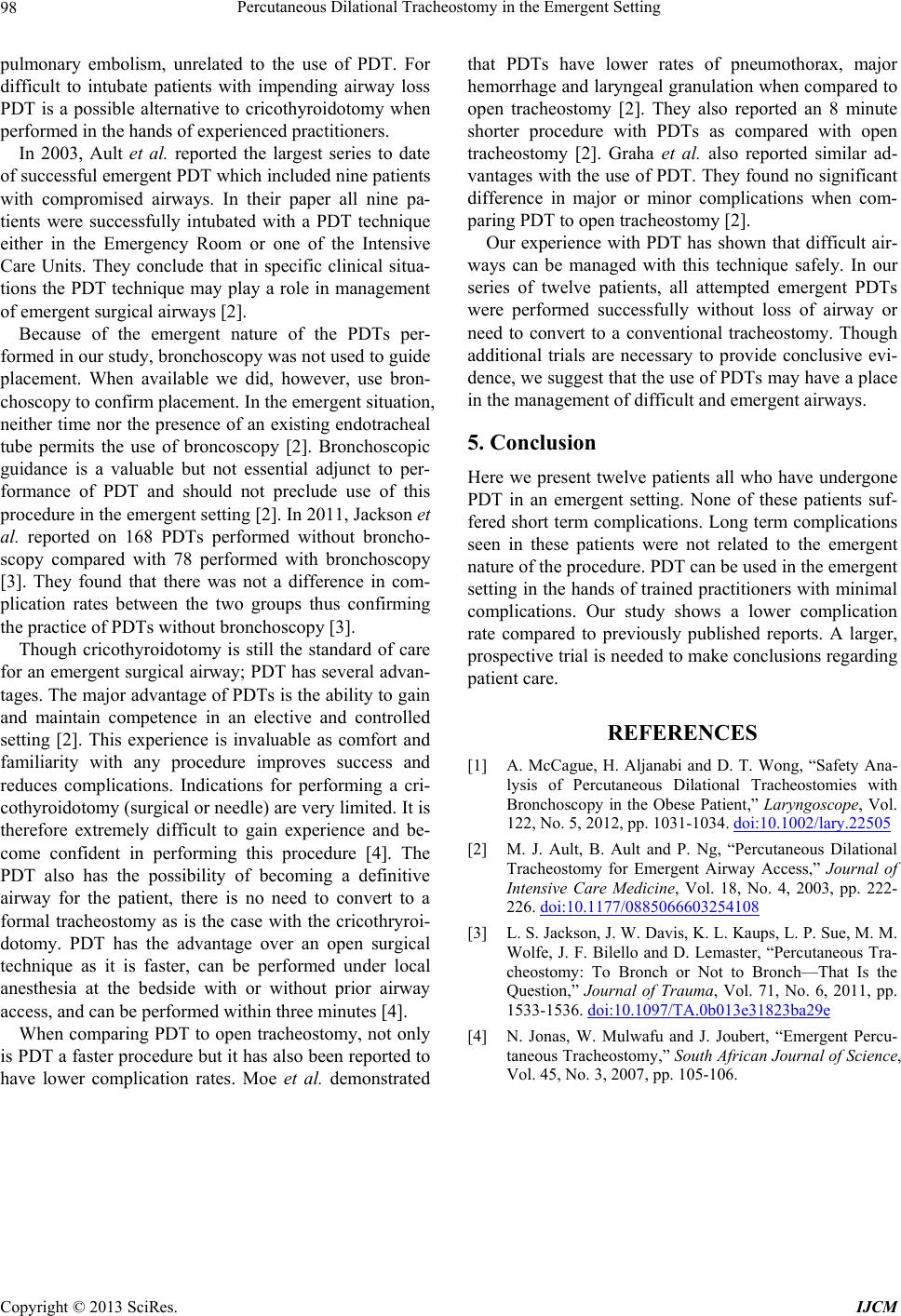
Percutaneous Dilational Tracheostomy in the Emergent Setting
98
pulmonary embolism, unrelated to the use of PDT. For
difficult to intubate patients with impending airway loss
PDT is a possible alternative to cricothyroidotomy when
performed in the hands of experienced practitioners.
In 2003, Ault et al. reported the largest series to date
of successful emergent PDT which included nine patients
with compromised airways. In their paper all nine pa-
tients were successfully intubated with a PDT technique
either in the Emergency Room or one of the Intensive
Care Units. They conclude that in specific clinical situa-
tions the PDT technique may play a role in management
of emergent surgical airways [2].
Because of the emergent nature of the PDTs per-
formed in our study, bronchoscopy was not used to guide
placement. When available we did, however, use bron-
choscopy to confirm placement. In the emergent situation,
neither time nor the presence of an existing endotracheal
tube permits the use of broncoscopy [2]. Bronchoscopic
guidance is a valuable but not essential adjunct to per-
formance of PDT and should not preclude use of this
procedure in the emergent setting [2]. In 2011, Jackson et
al. reported on 168 PDTs performed without broncho-
scopy compared with 78 performed with bronchoscopy
[3]. They found that there was not a difference in com-
plication rates between the two groups thus confirming
the practice of PDTs without bronchoscopy [3].
Though cricothyroidotomy is still the standard of care
for an emergent surgical airway; PDT has several advan-
tages. The major advantage of PDTs is the ab ility to gain
and maintain competence in an elective and controlled
setting [2]. This experience is invaluable as comfort and
familiarity with any procedure improves success and
reduces complications. Indications for performing a cri-
cothyroidotomy (surgical or needle) are very limited. It is
therefore extremely difficult to gain experience and be-
come confident in performing this procedure [4]. The
PDT also has the possibility of becoming a definitive
airway for the patient, there is no need to convert to a
formal tracheostomy as is the case with the cricothryroi-
dotomy. PDT has the advantage over an open surgical
technique as it is faster, can be performed under local
anesthesia at the bedside with or without prior airway
access, and can be performed within three minutes [4].
When comparing PDT to open tracheostomy, not only
is PDT a faster procedure but it has also been reported to
have lower complication rates. Moe et al. demonstrated
that PDTs have lower rates of pneumothorax, major
hemorrhage and laryngeal granulation when compared to
open tracheostomy [2]. They also reported an 8 minute
shorter procedure with PDTs as compared with open
tracheostomy [2]. Graha et al. also reported similar ad-
vantages with the use of PDT. They fou nd no significant
difference in major or minor complications when com-
paring PDT to open tracheostomy [2].
Our experience with PDT has shown that difficult air-
ways can be managed with this technique safely. In our
series of twelve patients, all attempted emergent PDTs
were performed successfully without loss of airway or
need to convert to a conventional tracheostomy. Though
additional trials are necessary to provide conclusive evi-
dence, we suggest that the use of PDTs may have a place
in the management of difficult and emergent airways.
5. Conclusion
Here we present twelve patients all who have undergone
PDT in an emergent setting. None of these patients suf-
fered short term complication s. Long term complications
seen in these patients were not related to the emergent
nature of the procedure. PDT can be used in the emergent
setting in the hands of trained practition ers with minimal
complications. Our study shows a lower complication
rate compared to previously published reports. A larger,
prospective trial is needed to make conclusions regarding
patient care.
REFERENCES
[1] A. McCague, H. Aljanabi and D. T. Wong, “Safety Ana-
lysis of Percutaneous Dilational Tracheostomies with
Bronchoscopy in the Obese Patient,” Laryngoscope, Vol.
122, No. 5, 2012, pp. 1031-1034. doi:10.1002/lary.22505
[2] M. J. Ault, B. Ault and P. Ng, “Percutaneous Dilational
Tracheostomy for Emergent Airway Access,” Journal of
Intensive Care Medicine, Vol. 18, No. 4, 2003, pp. 222-
226. doi:10.1177/0885066603254108
[3] L. S. Jackson, J. W. Davis, K. L. Kaups, L. P. Sue, M. M.
Wolfe, J. F. Bilello and D. Lemaster, “Percutaneous Tra-
cheostomy: To Bronch or Not to Bronch—That Is the
Question,” Journal of Trauma, Vol. 71, No. 6, 2011, pp.
1533-1536. doi:10.1097/TA.0b013e31823ba29e
[4] N. Jonas, W. Mulwafu and J. Joubert, “Emergent Percu-
taneous Tracheostomy,” South African Journal of Science,
Vol. 45, No. 3, 2007, pp. 105-106.
Copyright © 2013 SciRes. IJCM